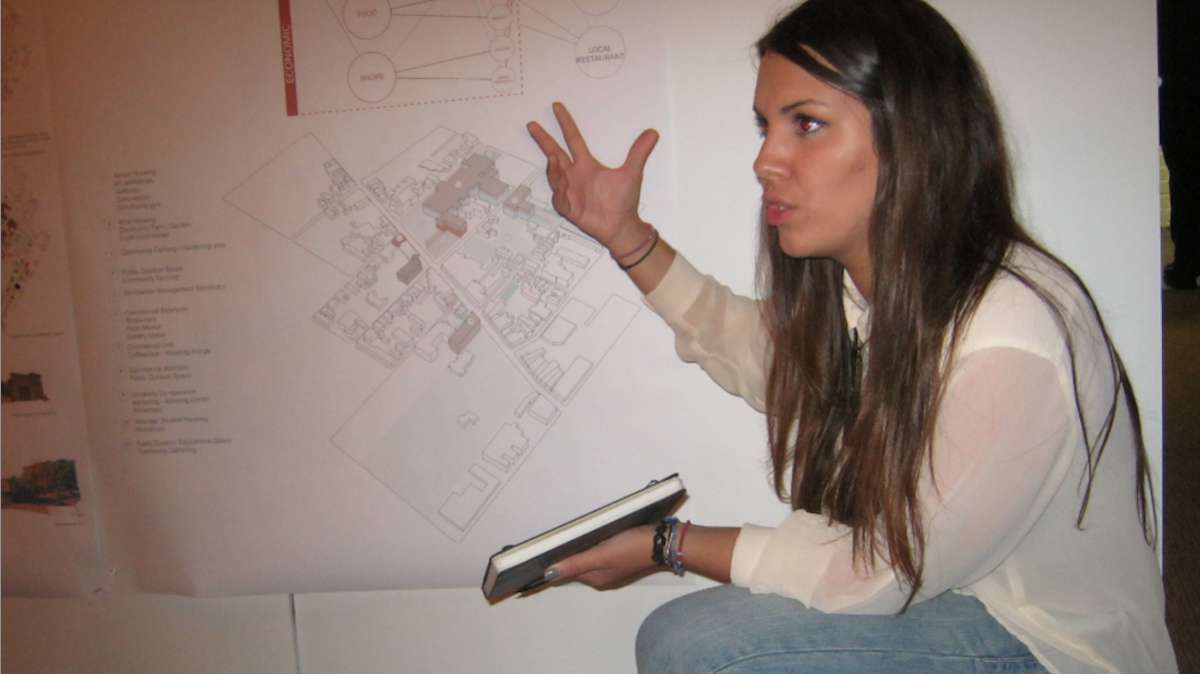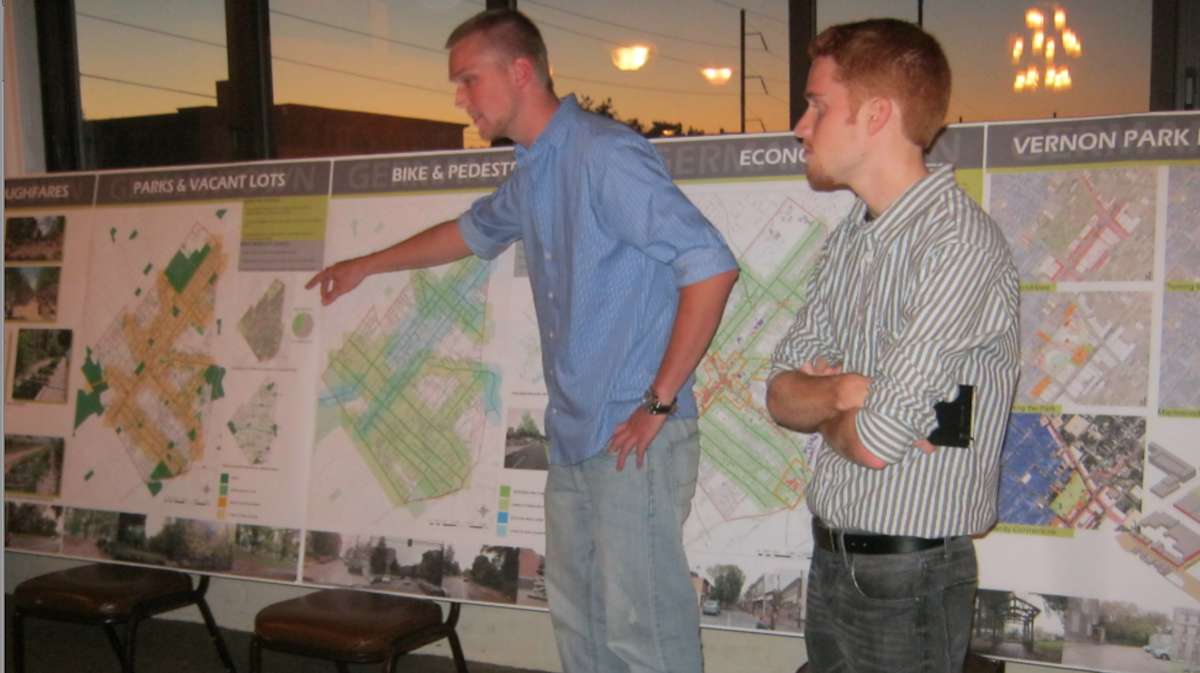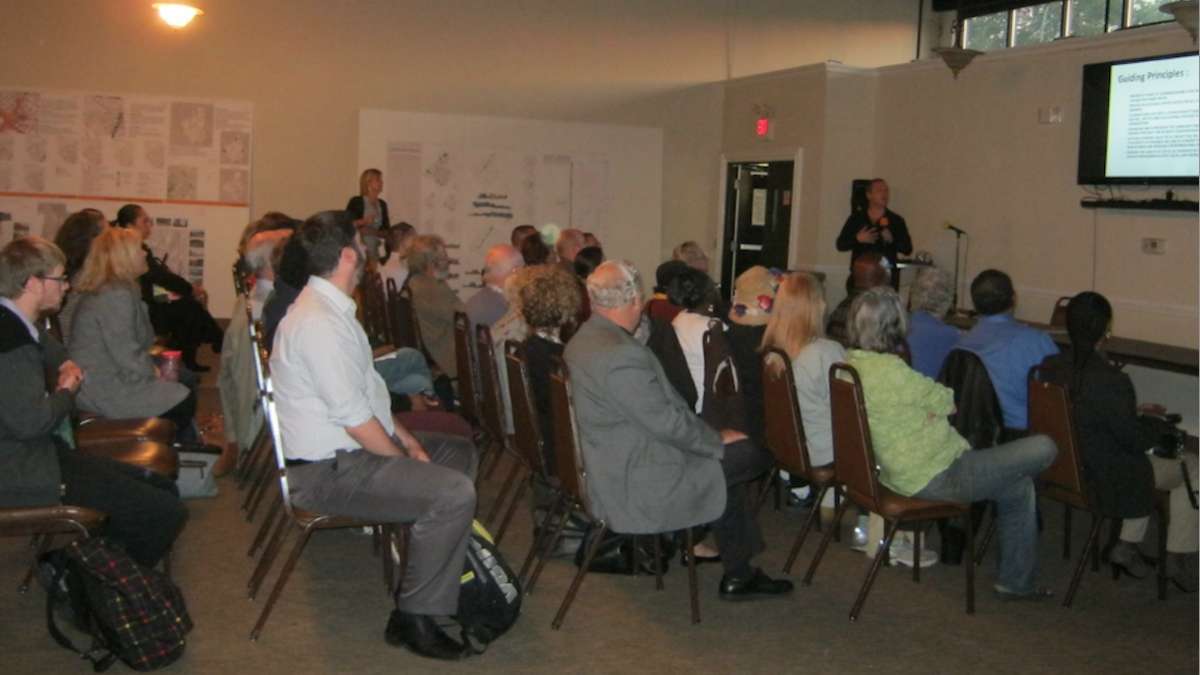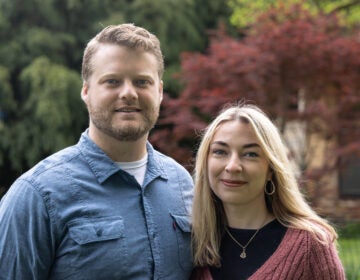Phila U. students meet with residents to discuss visions for Germantown’s future
Mt. Airy resident and Philadelphia University landscape-architect professor Kim Douglas knew that asking her students to develop “eco-district” plans for the revitalization of Germantown would be the easy part.
Sending the fifth-year architecture and landscape-architecture students out to present their plans to the community seeking feedback would be the real challenge.
“Germantown is really, really complicated,” Douglas said of the neighborhood that is now the focus of a special community-integrated Philadelphia University design study taking place this school year.
Chatting with NewsWorks during this week’s eco-district charrette at the Flying Horse Center, she said building the students’ plans on community input was vital to the project’s “ethics.”
What’s an eco-district?
Six groups of four students each — two in landscape architecture, two in architecture — are developing plans that focus on different locations and aspects of the neighborhood.
On Monday night, the groups presented initial plans at an open community session that drew a large group of curious locals.
Welcoming the group along with fellow Philadelphia University program leader Pablo Meninato, Douglas explained that “eco-district” refers to an interdisciplinary approach that encompasses not just architecture and landscape, but the cultural, social, economic, environmental and historical scene as well.
She said an eco-district is defined by collaboration and successful resource-sharing.
Some students found the prospect of sharing their initial analyses and plans with the community a bit nerve-wracking.
“People are so opinionated,” said Megan Crieg of interacting with outspoken locals. “Someone’s most likely not going to be happy with it.”
As Douglas pointed out, people who live in the district day-to-day will have a different perspective than those who study it from the outside, however in-depth their analysis. And so it would be that some locals took the opportunity to challenge the students’ assumptions and plans.
Feedback offered
Marika Mavroleon, one of Crieg’s teammates, said that community input filled an important gap in her understanding of the neighborhood.
After an initial survey, the team had designated a few areas on the neighborhood map as “underserved” because they lacked other areas’ amenities and services. However, locals pointed out that those seemingly blank spaces on the map are actually high-income residential areas which no Germantowner would classify as underserved.
“It’s hard to penetrate this community,” Germantown Artists Roundtable organizer Paula Paul said after listening to a few presentations. The students “are bringing a fresh look, but they don’t have that lived-in experience.”
Still, Paul applauded the students’ efforts and how they reached out to the community. Many attendees responded enthusiastically to the students’ ideas.
The plans
The evening’s presentations covered the early phases of the students’ work, including on-the-ground analysis and preliminary plans for an architectural, environmental, social and economic boost.
Justin Lentz, Chris Lousos, Kevin Peters and Logan Dry focused on Vernon Park and Maplewood Mall. Rather than approaching the project as a way to solve Germantown’s problems, Dry said they hoped to “build off of assets that Germantown already has.”
Talking with NewsWorks before the charrette got underway, they touted Vernon Park’s potential.
“It’s got good bones as far as green space and mature trees,” said Dry, adding that the park seems “isolated” with haphazard paths and little reason for passersby to enter. “It’s just something you drive past.”
The team presented the idea of galleries, shops and cafes that could open onto the park, as well as space for community sports, meeting places for church congregations, community gardens and even a performance area.
Other teams were full of ideas for other areas. They included a vision of the now-empty Germantown High School as a senior-living center; transforming vacant or underused buildings into housing for students of universities like Arcadia, Drexel and LaSalle; and finding a central location for Germantown’s many groups to connect.
“Germantown has at least 40 civic and community organizations, but they don’t have a common place to meet,” student Vanessa Miller said.
Beyond architecture
While there are not yet means to fund any of the plans, Douglas maintained that the efforts have their own rewards.
“Some [plans] may be pretty outrageous, some will make a lot of sense,” she said. “When you have a vision and drawings that show that vision, people start to get excited.”
Ultimately, the current project will result in a virtual 3-D model of what the neighborhood could be.
Douglas added that with Philadelphia University’s urban-based, service-oriented curriculum, assignments like this are a natural fit. Training that focuses on diversity, team-building and communication prepares the students for events like Monday’s charrette.
“Collaboration is as important as being able to draw a section,” she said.
The class hopes to hold another community meeting in early December. Locals who want to keep up in the meantime can visit the new Germantown Urban Studio blog, where constructive feedback in the comments is encouraged.
WHYY is your source for fact-based, in-depth journalism and information. As a nonprofit organization, we rely on financial support from readers like you. Please give today.








